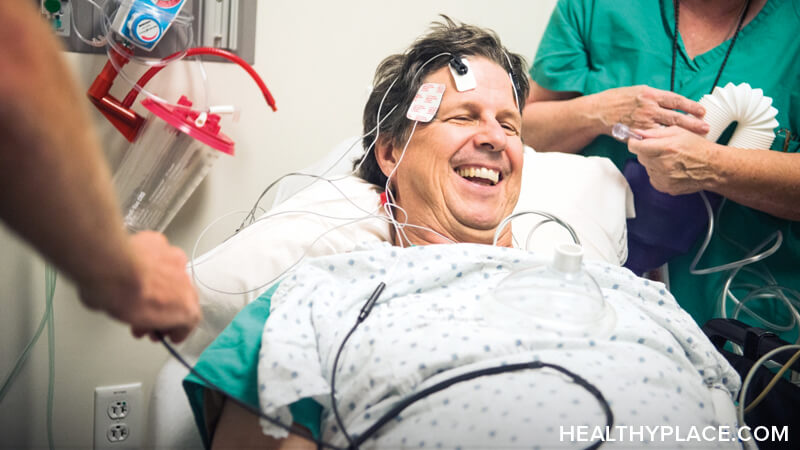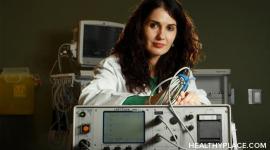Shock Treatment for Depression: How ECT Shock Therapy Works

"Shock therapy" was so-called, as an electric shock is used to induce a controlled seizure intended as a treatment, primarily for mood disorders, although other conditions may be treated as well. Shock therapy is now known as electroconvulsive therapy or ECT.
The brain is still not well understood, nor is the reason for the treatment effects ECT (shock) therapy has on some individuals. It is known that ECT affects hormones, neuropeptides, neurotrophic factors, and neurotransmitters in the brain. All of this may come together to explain how ECT works in treatment.
Shock therapy was overused and misused in the past and since has come to have a mixed reputation (read about the history of ECT procedure). Great care is now taken to ensure ECT treatment is warranted, and signed consent must typically be given before its use.
How to Prepare for a Shock Treatment
A full physical is generally needed before shock therapy. Because general anesthesia will be administered, one should not eat or drink 8-12 hours before the shock treatment. This helps to prevent any vomiting during the procedure. Other exams like an electrocardiogram (ECG) may also be given before ECT to ensure the procedure is safe and appropriate.
How Shock Therapy is Performed
Shock therapy is performed in a hospital, sometimes in an area specifically set aside for this treatment. An intravenous (IV) is inserted to provide anesthetic medication. Vital signs are taken initially and continuously throughout the shock therapy treatment.
An anesthesiologist administers anesthesia and after you are asleep, places a tube in your throat to help you breathe. A paralyzing agent called succinylcholine is then administered to prevent the seizure from spreading to your body. The electrodes are then applied to your head with conducting jelly and a brief shock (less than 2 seconds) is administered.
How Shock Therapy Feels
When you awake from the anesthesia, you may be confused and tired. You will likely experience short-term memory loss around the time of the procedure. With multiple treatments, this may increase. Adverse cognitive effects tend to be the most concerning factors around ECT and tend to affect the frequency and duration of treatments and whether ECT is offered at all. Your vital signs will be monitored closely after the shock treatment to ensure proper recovery. You may feel head, muscle or back pain. Such discomfort tends to be relieved by mild medications. If any post-treatment effect is concerning you, you should talk to the treating physician immediately.
Why Shock Therapy is Performed
It is most common to see shock therapy used in severe cases of depression. Shock therapy is also performed to improve the condition of the following disorders:1
- Acute mania
- Catatonia
- Occasionally, types of schizophrenia or other psychotic disorders
Electroconvulsive therapy has also shown effectiveness in treating other disorders such as neuroleptic malignant syndrome (a rare, severe, adverse reaction to antipsychotic medication).
Shock treatment for depression and other disorders is indicated when the patient needs rapid improvement because the patient is:
- Suicidal
- Self-injurious
- Refusing to eat or drink
- Refusing to take medication as prescribed
- A danger to themselves
- Psychotic
- Pregnant or otherwise can't take standard medications
Some patients need maintenance ECT. Find out why.
Risks Associated with Shock Therapy (ECT)
The complications associated with ECT / shock therapy are often related to electrode placement with bilateral placement (an electrode by each temple) typically showing greater unwanted cognitive effects than unilateral placement (one electrode at the temple and the other on the forehead). Risks of shock therapy include slow heart beat (bradycardia) and rapid heartbeat (tachycardia), as well as memory loss, confusion and other cognitive effects. Persons at high risk include those with recent heart attack, uncontrolled blood pressure, brain tumors and previous spinal injuries.
Read more comprehensive information about: ECT side effects.
Normal Results After Shock Treatment
Shock treatment for depression often produces a dramatic improvement in symptoms, especially in elderly individuals, sometimes during the first week of treatment. While it is estimated many of these patients will experience a future return of depression symptoms, the prognosis for each episode of depression is good. Mania also often responds well to shock treatment. The picture is not as bright for schizophrenia, which is more difficult to treat and is characterized by frequent relapses.
A small number of patients are placed on maintenance shock therapy. This means they return to the hospital every 1-2 months, as needed, for an additional treatment. These individuals choose shock therapy because it can keep their illness under control and help them lead a normal and productive life.
APA Reference
Tracy, N.
(2022, January 4). Shock Treatment for Depression: How ECT Shock Therapy Works, HealthyPlace. Retrieved
on 2025, December 23 from https://www.healthyplace.com/depression/ect/shock-treatment-for-depression-how-ect-shock-therapy-works



